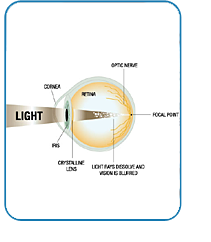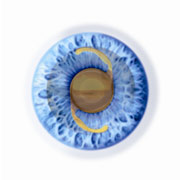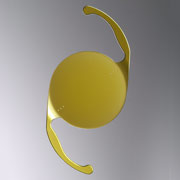 Cataract surgery at Vista Eye Specialists is tailored to each individual according to their own specific needs. Dr. Binoy Jani is a talented eye doctor that is committed to eliminating cataracts and improving your eyesight with the latest, most innovative technologies, including premium intraocular lens implants (IOL). Intraocular lenses such as ReSTOR®, Tecnis, Tecnis Symforny, and Crystalens® replace the natural crystalline lens of the eye that is typically clouded over by cataracts. The results in vision improvement are usually so great that patients no longer need eyeglasses or contacts. Consider premium IOLs to restore the quality eyesight you had when you were younger, as well as your quality of life.
Cataract surgery at Vista Eye Specialists is tailored to each individual according to their own specific needs. Dr. Binoy Jani is a talented eye doctor that is committed to eliminating cataracts and improving your eyesight with the latest, most innovative technologies, including premium intraocular lens implants (IOL). Intraocular lenses such as ReSTOR®, Tecnis, Tecnis Symforny, and Crystalens® replace the natural crystalline lens of the eye that is typically clouded over by cataracts. The results in vision improvement are usually so great that patients no longer need eyeglasses or contacts. Consider premium IOLs to restore the quality eyesight you had when you were younger, as well as your quality of life.
IOL (INTRAOCULAR LENS) PROCEDURE – NO STITCH
Typically used for the treatment of cataracts, the procedure involves an insertion of an IOL under local anesthesia with the patient awake and very comfortable throughout the operation. The use of a flexible IOL enables the lens to be rolled for insertion into the capsule through a very small incision, thus avoiding the need for stitches. The procedure usually takes less than 20 minutes, with a recovery period about 2–3 weeks. For several months after the procedure, patients will need to visit with Dr. Jani or their eye care provider to monitor the implants.
ZEISS IOL MASTER
At Vista Eye Specialists, we utilize the Carl Zeiss Meditec IOL Master®, an advanced technology used to evaluate the length of the eye, surface curvature, and intraocular lens power.
Accurate measurements are necessary for cataract surgery or other lens-replacement procedures since each patient’s individual powers and sizes vary. The IOL Master is currently one of the most advanced technologies used to provide the precise measurements needed in order to ensure the best possible outcome for cataract surgery. These measurements are used by Dr. Jani to calculate the best intraocular lens to implant in the eye. Testing is fast and efficient (one minute or less per eye), and both patient safety and comfort is enhanced. Also, because the IOL Master is non-contact (nothing touches the eye itself), there is no need for anesthesia and there is no potential for eye infection from the IOL Master. In addition, the IOL Master represents a five-fold increase in accuracy over measurements made by traditional A-scan ultrasonography devices.
Carl Zeiss Meditec IOL Master® has been approved by the Food and Drug Administration (FDA) since March 2000. For more information, click here.
HAAG – Streit Lenstar Biometry
At Vista Eye Specialists, we continue to invest in the best technology with the recent addition of the Lenstar LS 900 biometer. Lenstar is an advanced technology used to evaluate the length of the eye, surface curvature, and intraocular lens power. As more information and research progresses, newer formulas, equipment, and techniques come to light. At Vista Eye Specialists we are always looking for ways to further perfect our patient experience and surgical outcomes. For more information, click here.
Pentacam® HR – Core Functions
Within a mere second the Pentacam® supplies you with precise diagnostic data on the entire anterior eye segment. The degree of cataract is made visible by the light scattering properties of the eye lens. Learn more about Pentacam® HR technology.
TYPES OF IOLs
Monofocal IOLs
Monofocal lens implants are basic IOLs that most insurance companies will pay for during cataract surgery. Monofocal IOLs allow patients to see at a distance, but not necessarily near or intermediate vision, so patients would still need to wear glasses, bifocals, or contact lenses after surgery to read or see at near distances.
Multifocal, Extended Depth of Focus (EDOF), and Accommodative Intraocular Lenses
The premium advanced IOLs which restore distance, near, and intermediate vision are Crystalens, ReSTOR®, Tecnis Symfony, and Tecnis Multifocal intraocular lenses. Depending on the intraocular lens you choose, these lenses will help with near, far, and in between vision. Advanced IOLs offer a wider range of vision than traditional monofocal implants and studies show that up to 80% of patients no longer use any form of optical correction after having this procedure. Each lens has a unique design, with certain advantages for distance, near, and intermediate vision tasks. This translates into greater freedom and independence for you at work, home or wherever your hobbies and interests lead you.
Multifocal, EDOF, and Accommodative Intraocular Lenseshave been approved by the Food and Drug Administration (FDA)
As with any surgical procedure, choosing an experienced surgeon is the first step in a successful outcome. Dr. Jani is fellowship trained surgeon who has performed thousands of cataract surgeries and will help you determine which lens is right for you.
- AcrySof IQ Vivity
- TECNIS SYMFONY
- PanOptix Trifocal Lens
- RESTOR®
- CRYSTALENS®
- TECNIS MUTIFOCAL IOL
- TORIC ASTIGMATISM IOL
When Can I Drive after Vivity IOL?
 You will not be able to drive for at least the first 24 hours after cataract surgery or refractive lens exchange (RLE). During your surgical follow-up the next day, Dr. Jani will discuss the potential limitations during your recovery, including when it’s safe to drive again. He will assess your vision and give you a reasonable estimate as to when you can expect to get behind the wheel safely.
You will not be able to drive for at least the first 24 hours after cataract surgery or refractive lens exchange (RLE). During your surgical follow-up the next day, Dr. Jani will discuss the potential limitations during your recovery, including when it’s safe to drive again. He will assess your vision and give you a reasonable estimate as to when you can expect to get behind the wheel safely.
Generally, vision is greatly improved four to six weeks after Vivity IOL or another IOL placement, but some patients may see clearly as soon as a few days or the next day after surgery.
Is Vivity IOL a Permanent Solution for Good Vision?
While it’s possible for your vision to degrade with age due to presbyopia and eye diseases (including cataracts), intraocular lens implants such as Vivity IOL are permanent and do not need to be replaced. You can enjoy long-lasting vision improvement with Vivity IOL, and many patients enjoy clear vision for the rest of their life.
How Much Does Vivity IOL Cost?
Many factors impact the cost of AcrySof IQ Vivity IOL, including the surgeon’s experience and skill, surgery center facility fees and whether a laser is involved.. Vivity IOL is an extended-depth-of-field artificial lens that will have out of pocket costs. Our staff in Fredericksburg, Virginia, and Culpeper, Virginia, will provide a cost estimate for your Vivity IOL and help you with interest-free financing options.
AcrySof IQ Vivity
One of the latest advancements in premium intraocular lenses is the Vivity IOL, built on Alcon’s AcrySof IQ platform. The extended depth of focus IOL is used in patients who want to achieve quality distance and intermediate vision while mitigating the effects of presbyopia (the age-related loss of close-up vision) after cataracts. The lens is implanted in the eye toward the end of cataract surgery, after the eye’s natural, cloudy lens has been removed.
Vivity was FDA approved in 2020, and has received excellent reviews from ophthalmologists and high patient satisfaction rates. With the Vivity IOL, patients can regain the clear vision they need to read, write and work on a computer.
How the Vivity IOL Works
Vivity is the first of its kind, designed with a new non-diffractive technology called X-Wave. Unlike other diffractive multifocal lenses, Vivity does not split light into separate focal points. Instead, it stretches and shifts light rays to focus on the retina, creating an extended range of vision.
One of the drawbacks of other multifocal lenses is that they provide clear, functional vision but are associated with high incidences of visual disturbances, such as halos around lights, starbursts and glare. These visual disturbances are particularly bothersome when trying to drive at night, because they can obscure traffic lights, signs, other cars and pedestrians. Because of its unique non-diffractive technology, Vivity is associated with significantly lower incidences of visual disturbances, making it highly advantageous for night driving.
Another remarkable capability of the Vivity IOL is that it can correct astigmatism. A toric version of the IOL is available for patients with pre-existing astigmatism.
Will I Need Glasses with the AcrySof IQ Vivity IOL?
Whether a patient requires glasses with the Vivity IOL is highly dependent on the individual. Generally, most patients are able to go about their day-to-day routine without an urgent need for glasses, unless they are performing specific close-up tasks such as reading very small print (like the label on a bottle of medicine).
In a U.S. clinical trial, 94 percent of patients implanted with the Vivity lens reported very good or good distance vision without glasses, and 92 percent reported similar ratings for intermediate (i.e., arm’s length) vision. Forty-seven percent of Vivity patients were able to read a book without requiring glasses.
One thing is for certain: the Vivity IOL offers a much greater range of visual acuity than monofocal IOLs (which only correct for distance or close-up vision, but not for both). Not only is the range of vision broader, but the quality of vision is superior, too. Many patients say their visual quality with Vivity is comparable to what they enjoyed when they were much younger.
Dr. Jani and the team at Vista Eye Specialists evaluate candidates for the Vivity IOL on an individual basis. They also review the highlights and drawbacks of the new lens, as compared to other premium IOLs, during cataract consultations.
Tecnis Symfony IOL
Thanks to incredible technological advances, today’s IOL patients have plenty of choices. The Tecnis Synergy, an extended range of vision IOL, is incredibly popular among those individuals who want a lens that provides clear vision while reducing dependence on corrective eyewear.
The IOL is specifically engineered to deliver a continuous range of quality vision at near, far and intermediate distances. It works for patients with or without astigmatism (an abnormal curvature of the eye’s cornea that causes blurry vision). Many patients who select the Tecnis Synergy are able to forego glasses for their daily activities, including driving, working on a computer and reading.
How the Tecnis Synergy IOL Works
Unlike other IOLs, which split light into different focal points, the Synergy IOL elongates the eye’s focus curve. The result: continuously clear vision at nearly any distance.
The Synergy lens is high performing in virtually all lighting conditions; even in low light situations. Synergy patients can feel confident getting behind the wheel, even at night, without worrying about blinding or fragmented light obscuring their view of the road or road signs.
Who Is a Good Candidate for the Synergy IOL?
The Synergy IOL is a solid choice for cataract patients with pre-existing presbyopia who want clear uncorrected vision. The IOL is available in a toric version for patients with astigmatism.
PanOptix Trifocal Lens
The AcrySof IQ PanOptix trifocal lens is the first in a new class of IOLs: the trifocal IOL. Instead of settling for average vision at a single distance, PanOptix patients can get the distance vision they need for safe driving, the intermediate vision they need for computer work and the near vision required for reading printed materials. Thanks to the unique design and features of the PanOptix lens, patients are achieving crisp, rich vision akin to what they enjoyed when they were much younger.
How the PanOptix Trifocal Works
The PanOptix trifocal lens is unique in that it splits light into three focal points: near, far and intermediate. Patients with the PanOptix IOL can see objects at nearly any distance simultaneously, and with little need for glasses. The PanOptix has been associated with lower rates of visual disturbances such as halos and glare, which are common with other multifocal IOLs.
Who Is a Good Candidate for the PanOptix Trifocal?
The trifocal IOL is recommended for cataract patients who want great vision at all distances. The IOL was designed with the active adult in mind. It is ideal for someone who wants to go from work to the tennis court to dinner with friends — all without relying on glasses for certain activities. The PanOptix lens is also perfect for the avid swimmer, golfer or hunter.
The PanOptix toric IOL is offered to patients with astigmatism who wish to reduce dependence on corrective eyewear.
Can PanOptix Eliminate the Need for Reading Glasses?
 Yes, in most patients. AcrySof IQ PanOptix Trifocal IOL was explicitly designed with presbyopia in mind. This artificial lens is the only FDA-approved trifocal IOL, and the lens can mitigate the loss of near vision caused by the stiffening of the eye’s natural lens (presbyopia). PanOptix can reduce or eliminate your dependence on reading glasses.
Yes, in most patients. AcrySof IQ PanOptix Trifocal IOL was explicitly designed with presbyopia in mind. This artificial lens is the only FDA-approved trifocal IOL, and the lens can mitigate the loss of near vision caused by the stiffening of the eye’s natural lens (presbyopia). PanOptix can reduce or eliminate your dependence on reading glasses.
How Long Does PanOptix Trifocal IOL Last?
PanOptix Trifocal IOL and other IOLs do not degrade or break down with age and typically last a lifetime, so choosing the right artificial implant for your lifestyle and vision needs is very important.
What’s the Price of PanOptix Trifocal IOL?
The total cost of your procedure and PanOptix IOL depends on the type of surgery (cataract vs. RLE), whether laser technology is used, the surgeon’s and facility’s expenses and other factors. PanOptix is a one-of-a-kind artificial lens implant that can help free you from contact lenses, prescription glasses and reading glasses and is not covered by insurance. Our office can help provide a cost estimate and help you with interest free financing options.
Panoptix Trifocal vs. Vivity: Which is Right for You?
A 2022 analysis published in Clinical Ophthalmology evaluated various IOLs on the market for their efficacy, including the rate of visual disturbances, independence from corrective eyewear and patient satisfaction. Patients with the AcrySof IQ Vivity IOL reported less glare and fewer halos in low-lit situations (85 percent) than PanOptix patients (69 percent). However, 83 percent of PanOptix patients reported complete vision independence, meaning they did not require any forms of corrective eyewear, including reading glasses, compared to 33 percent of Vivity IOL patients. Overall, patient satisfaction was high in both groups. The analysis noted no significant difference in “best-corrected visual acuity” and no new safety concerns1.
Both of these IOLs can significantly improve your vision, and the right one for you may come down to your lifestyle. Dr. Jani is one of the most experienced eye surgeons in Fredericksburg/Culpeper and can recommend the best IOL for your needs during your consultation and eye exam.
Reference:
1. Hovanesian, J. A., Jones, M., & Allen, Q. (2022). The vivity extended range of vision IOL vs the Panoptix Trifocal, Restor 2.5 active focus and Restor 3.0 multifocal lenses: A comparison of patient satisfaction, visual disturbances, and Spectacle Independence. Clinical Ophthalmology, Volume 16, 145–152. https://doi.org/10.2147/opth.s347382
RESTOR®
 AcrySof® IQ ReSTOR® IOL corrects the condition for patients with cataracts and presbyopia (the hardening of the natural lens that comes with age) at the same time, eliminating or reducing the need for eye glasses after surgery in most patients. RESTOR® has been uniquely designed to provide enhanced image quality and a full range of vision – up close, far away and everything in-between – giving cataract patients the best opportunity to live life free of glasses.
AcrySof® IQ ReSTOR® IOL corrects the condition for patients with cataracts and presbyopia (the hardening of the natural lens that comes with age) at the same time, eliminating or reducing the need for eye glasses after surgery in most patients. RESTOR® has been uniquely designed to provide enhanced image quality and a full range of vision – up close, far away and everything in-between – giving cataract patients the best opportunity to live life free of glasses.
The center of the ReSTOR® IOL lens surface consists of a series of tiny rings in the gradual tapering of different diffractive levels (or “steps”) on a lens, creating a smooth transition of light between distant, intermediate and near focal points. This results in the tiny steps in the center of the ReSTOR® IOL work together to focus light, providing near vision, intermediate vision, and distance vision. The outer ring of the ReSTOR® is a refractive region designed for distance vision. This refractive area bends light as it passes through the lens, accurately focusing it on the retina (the transmitter located at the back of your eye that sends the images to your brain for a crisp, clear image).
ReSTOR® multifocal IOLs have been approved by the Food and Drug Administration (FDA) since March 2005. For more information, click here.
Crystalens®
Crystalens® is an accommodative intraocular lens implantation that is used to correct presbyopia. Crystalens® was modeled after the human eye, which like the natural lens uses the eye muscle to flex and accommodate in order to focus on objects in the environment at all distances using the eye’s natural focusing system. Crystalens® focuses only one image to the back of the eye, unlike a multifocal lens that projects multiple images that are not entirely in focus, requiring your brain to “adjust” to the differences. Crystalens® is a unique, flexible lens designed with flexible hinges that provides excellent distance and intermediate vision, dynamically adjusting to your visual needs.
It is a great choice for computer users and those involved with near tasks slightly beyond a standard reading distance. This lens may not provide the greatest independence from reading glasses but it will provide excellent distance and intermediate reading. In addition, few patients with Crystalens® have experienced glare, halos and night vision problems.
Presbyopia is a result of the natural lens in each eye becoming less flexible, so that it doesn’t change shape as it should to properly focus on objects up-close. The changing of the shape is called accommodation. The Crystalens® is the first intraocular lens for patients with cataracts that provides accommodation. This revolutionary procedure is generally for adults over the age of 40 who desire high quality vision without the assistance of bifocals or trifocals. The vision results are remarkable, producing an overall clearer vision through better contrast sensitivity and depth of focus.
Crystalens® is the only accommodating intraocular lens approved by the Food and Drug Administration (FDA) since November 2003. For more information, click here.
Tecnis Multifocal IOL
Tecnis Multifocal® IOL corrects the condition for patients with cataracts and presbyopia (the hardening of the natural lens that comes with age) at the same time, eliminating or reducing the need for eye glasses after surgery in most patients. Tecnis® has been uniquely designed to provide enhanced image quality and a full range of vision – up close, far away and everything in-between – giving cataract patients the best opportunity to live life free of glasses.
The center of the Tecnis® IOL lens surface consists of a series of tiny rings in the gradual tapering of different diffractive levels (or “steps”) on a lens, creating a smooth transition of light between distant, intermediate and near focal points. This results in the tiny steps in the center of the Tecnis® IOL work together to focus light, providing near vision, intermediate vision, and distance vision.
Tecnis® multifocal IOLs have been approved by the Food and Drug Administration (FDA). For more information, click here.
Toric Astigmatism IOL
 The AcrySof® Toric IOL is a monofocal lens that is uniquely designed to correct cataracts as well as a wide range of astigmatism. The surgery to remove cataracts is an outpatient procedure, and involves replacing the clouded natural lens with an artificial one. However, if you also have astigmatism you may still experience blurred or distorted vision, since the lens typically implanted during ordinary cataract surgery cannot correct this secondary condition. The Toric IOL is a foldable, single piece lens that is implanted during cataract surgery to replace the clouded lens. The unique design of the Toric IOL makes it possible to reduce or eliminate astigmatism and significantly improve uncorrected distance vision.
The AcrySof® Toric IOL is a monofocal lens that is uniquely designed to correct cataracts as well as a wide range of astigmatism. The surgery to remove cataracts is an outpatient procedure, and involves replacing the clouded natural lens with an artificial one. However, if you also have astigmatism you may still experience blurred or distorted vision, since the lens typically implanted during ordinary cataract surgery cannot correct this secondary condition. The Toric IOL is a foldable, single piece lens that is implanted during cataract surgery to replace the clouded lens. The unique design of the Toric IOL makes it possible to reduce or eliminate astigmatism and significantly improve uncorrected distance vision.
The Toric IOL can provide a higher quality of vision than a conventional lens in astigmatism patients and will reduce, but not eliminate the need for some glasses use. Risks include blurry vision due to the lens rotating out of position, with the possibility of further surgery to reposition or replace the IOL. Supplemental laser vision correction or limbal relaxing incisions may be needed to further reduce any residual astigmatism.
AcrySof® Toric IOLs have been approved by the Food and Drug Administration (FDA) since September 2005. For more information, click here.
At Vista Eye, we are on the cutting edge of technology with the latest advances in IOLs. Dr. Jani is a fellowship trained cornea surgeon who has performed thousands of cataract surgeries. Please contact Vista Eye for more information on IOLs, or to schedule an appointment.
While most Medicare and private insurance plans will cover basic cataract surgery costs, the patient will need to pay additional out-of-pocket costs to cover the price of a premium IOL that is considered not medically necessary by Medicare and private insurance plans. We offer interest free financing to help our patients choose these amazing technologies.


